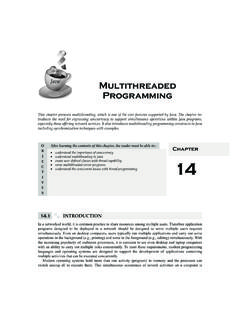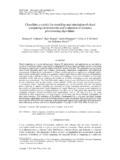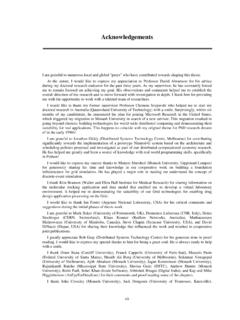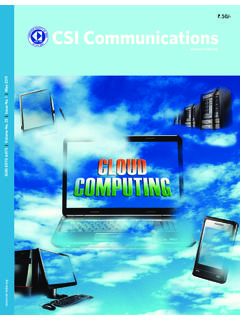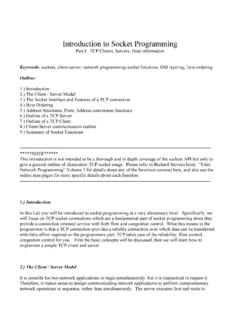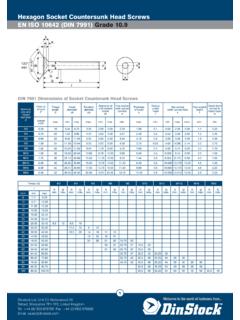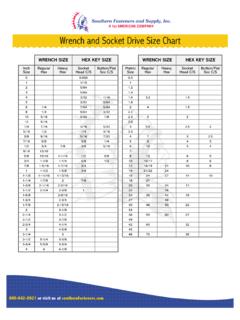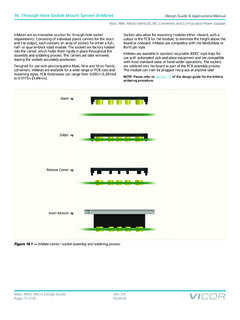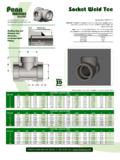Transcription of O A er learning the contents of this chapter, the reader ...
1 JavaSocket ProgrammingA er learning the contents of this chapter , the reader will be able to: understand fundamental concepts of computer communication understand sockets and ports understand package features program Java sockets create comprehensive network applications using sockets this chapter presents key concepts of intercommunication between programs running on diff erent computers in the network. It introduces elements of network programming and concepts involved in creating network applications using sockets . The chapter introduces the package containing various classes re-quired for creating sockets and message communication using two diff erent protocols.
2 It provides several example programs demonstrating various capabilities supported by Java for creating network .1 INTRODUCTIONI nternet and WWW have emerged as global ubiquitous media for communication and changed the way we conduct science, engineering, and commerce. They are also changing the way we learn, live, enjoy, communicate, interact, engage, etc. The modern life activities are getting completely centered around or driven by the take advantage of opportunities presented by the Internet, businesses are continuously seeking new and innovative ways and means for offering their services via the Internet.
3 this created a huge demand for software designers and engineers with skills in creating new Internet-enabled applications or porting existing/legacy applications to the Internet platform. The key elements for developing Internet-enabled applications are a good understanding of the issues involved in implementing distributed applications and sound knowledge of the fundamental network programming Socket Programming Client/Server CommunicationAt a basic level.
4 Network-based systems consist of a server , client , and a media for communication as shown in Fig. A computer running a program that makes a request for services is called client machine. A computer running a program that offers requested services from one or more clients is called server machine. The media for communication can be wired or wireless network. Fig. Client Server communicationGenerally, programs running on client machines make requests to a program (often called as server program) running on a server machine. They involve networking services provided by the transport layer, which is part of the Internet software stack, often called TCP/IP (Transport Control Protocol/Internet Protocol) stack, shown in Fig.
5 The transport layer comprises two types of protocols, TCP (Transport Control Protocol) and UDP (User Datagram Protocol). The most widely used programming interfaces for these protocols are sockets . TCP is a connection-oriented protocol that provides a reliable fl ow of data between two computers. Example applications that use such services are HTTP, FTP, and is a protocol that sends independent packets of data, called datagrams, from one computer to another with no guarantees about arrival and sequencing. Example applications that use such services include Clock server and TCP and UDP protocols use ports to map incoming data to a particular process running on a computer.
6 Port is represented by a positive (16-bit) integer value. Some ports have been reserved to support common/well known services: ftp 21/tcp telnet 23/tcp smtp 25/tcp login 513/tcp http 80/tcp,udp https 443/tcp,udpUser-level process/services generally use port number value >= TCP/IP so ware stack348 Object-Oriented Programming with Java Fig. TCP/UDP mapping of incoming packets to appropriate port/processObject-oriented Java technologies sockets , threads, RMI, clustering, Web services have emerged as leading solutions for creating portable, effi cient, and maintainable large and complex Internet Hosts Identifi cation and Service PortsEvery computer on the Internet is identifi ed by a unique, 4-byte IP address.
7 this is typically written in dotted quad format like where each byte is an unsigned value between 0 and 255. this representation is clearly not user-friendly because it does not tell us anything about the content and then it is diffi cult to remember. Hence, IP addresses are mapped to names like or , which are easier to remember. Internet supports name servers that translate these names to IP addresses. In general, each computer only has one Internet address. However, computers often need to communicate and provide more than one type of service or to talk to multiple hosts/computers at a time. For example, there may be multiple ftp sessions, web connections, and chat programs all running at the same time.
8 To distinguish these services, a concept of port s, a logical access point, represented by a 16-bit integer number is used. That means, each service offered by a computer is uniquely identifi ed by a port number. Each Internet packet contains both the destination host address and the port number on that host to which the message/request has to be delivered. The host computer dispatches the packets it receives to programs by looking at the port numbers specifi ed within the packets. That is, IP address can be thought of as a house address when a letter is sent via post/snail mail and port number as the name of a specifi c individual to whom the letter has to be sockets and Socket-based CommunicationSockets provide an interface for programming networks at the transport layer.
9 Network communication using sockets is very much similar to performing fi le I/O. In fact, socket handle is treated like fi le streams used in fi le I/O operation are also applicable to socket-based I/O. Socket-based communication is independent of a programming language used for implementing it. That means, a socket program written in Java language can communicate to a program written in non-Java (say C or C++) socket server (program) runs on a specifi c computer and has a socket that is bound to a specifi c port. The server listens to the socket for a client to make a connection request (see Fig.)
10 If everything goes well, the server accepts the connection (see Fig. ). Upon acceptance, the server gets a new socket bound to a different port. It needs a new socket (consequently a different port number) so that it can continue to listen to the original socket for connection requests while serving the connected client. Socket Programming 349 Fig.
